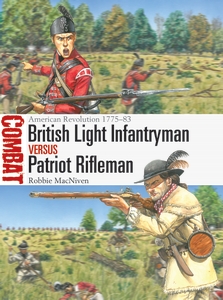
An oft-repeated tenet of older Revolutionary War histories, especially popular ones, is that the rifles used by Patriot forces offered them an important advantage over the British, who were unaccustomed to having to deal with long-range marksmen. While there is a kernel of truth to this assertion, in reality the rifle played only a minor role in deciding the outcome of the war, even more so when measured against the importance it has subsequently assumed among some commentators.
Interestingly, the rifle started the war with just as high a reputation as it later reacquired. In 1775, a number of Patriot commanders believed the rifle would prove crucial in coming campaigns. The arrival of a number of companies of frontiersmen – dressed in hunting shirts and armed with long rifles – at the Patriot encampment outside Boston caused a stir in the colonies. The riflemen gave demonstrations of their pinpoint accuracy, and commentators like John Adams wrote effusively about the effect they would surely have once they reached combat.
The assumption was misplaced, for the rifle companies soon became more of a liability than a boon. Given special treatment by Washington, but with little to occupy them during the siege of Boston, they began to foment disciplinary issues, and some even threatened to mutiny. Senior Patriot officers quickly grew tired of such antics among the riflemen, and both their numbers and some of their special privileges within the Continental Army were curtailed.
For their own part, the British displayed a great deal of trepidation towards Patriot riflemen early in the war. The weapon’s reputation preceded it, and British officers in particular feared they would quickly become casualties due to the weapon’s long-range accuracy. In reality, their odds of survival were greater than many assumed. British losses among the officer corps during the Revolutionary War were not in excess of other conflicts of the period, and even the most well-publicised ranged kills may not have been inflicted by rifles. Brigadier General James Agnew, for example, was supposedly sniped from behind the wall of a churchyard at the battle of Germantown by a rifle-armed civilian, but the claim appears much later, and a primary eyewitness describes him as being hit during the volley of smoothbore muskets. Similarly, even the famous death of Brigadier General Simon Fraser at the battle of Bemis Heights has only scanty evidence connecting it to the famed rifleman Patrick Murphy.
Under Washington’s orders, the number of riflemen in the Continental Army was scaled back and then kept at a small but steady number. With the rifles used by Patriot forces originally being intended as hunting tools, they often proved unsuited to the rigors of warfare. They could be broken relatively easily, were more difficult to maintain on campaign, and lack of standardization meant that supplying ammunition and other equipment was a reoccurring problem. A number of Patriot officers actively reequipped their rifle-armed troops with smoothbore muskets and bayonets.
The utility the rifle could offer in ranged combat was still appreciated, though it had to be used wisely. The British quickly learned that aggressive bayonet charges were the best antidote to ranged tactics, and could even engage them successfully in firefights if the riflemen were inexperienced. One British officer, Captain William Dansey, wrote of his dismay at finding riflemen to be as inaccurate as they were, and related besting them with his smoothbore-armed company on several occasions. Another Continental officer, Charles Lee, issued exasperated orders to his riflemen not to fire at targets about 150 yards away, as they almost always missed.
While it did not live up to its initial reputation, the rifle was not negligible either. Patriot commanders discovered that riflemen alone were vulnerable, but when used to augment a force armed with smoothbore muskets and – importantly – bayonets, they became far more potent. Patriot rifles took a toll on the British at Freeman’s Farm (albeit after initially being almost routed) and on the Hessians at Fort Washington, and riflemen aided the deadly partisan war that raged in the South especially during 1780–81. The British certainly appreciated the rifle enough to employ large numbers of their own riflemen – German Jäger and Loyalists among them – as well as the British Army’s first service rifle, the 1776 pattern, modelled on German hunting designs and shipped over en masse for the use of British forces. Indeed, it has been suggested that rifles were employed as much by Crown Forces as they were by the Patriots. For both sides, however, the idea of the rifle as a super-weapon that would significantly contribute towards victory was largely misplaced.
If you enjoyed today's blog post you can learn more in British Light Infantryman vs Patriot Rifleman.


Comments
You must be logged in to comment on this post. Click here to log in.
Submit your comment